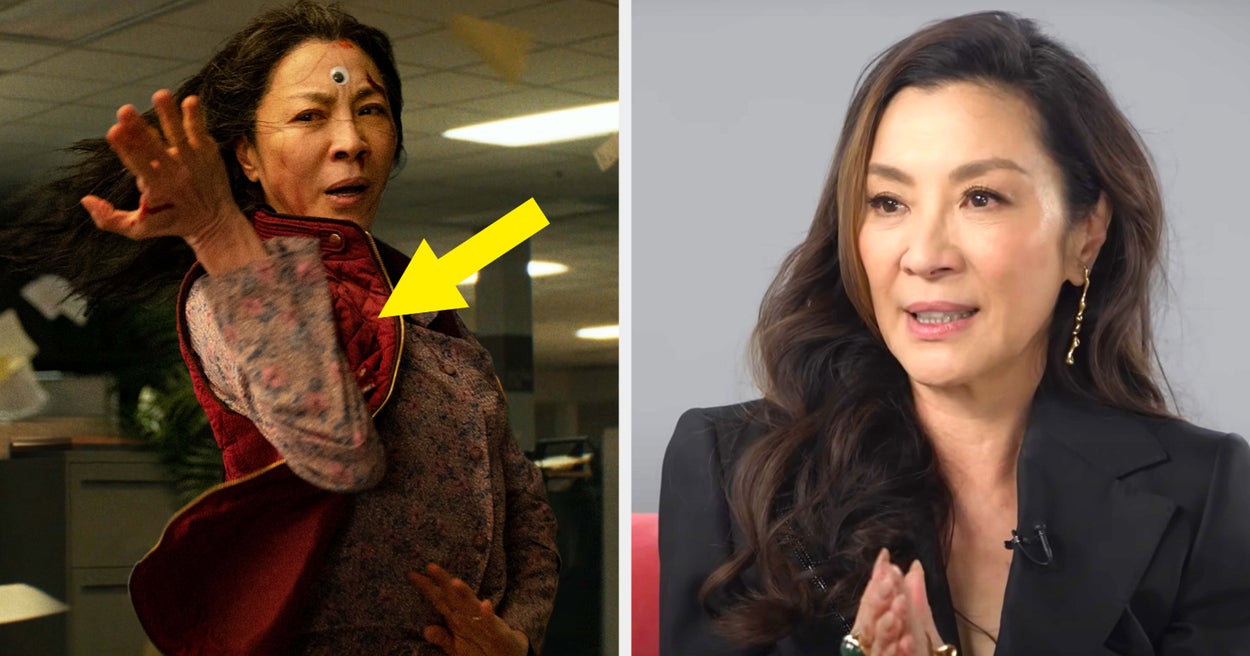It’s no secret that Everything Everywhere All At Once — which explores existentialism and the Asian American identity through multiverse “jumping” and, you know, bagels — has been a huge hit. It’s been named one of the top 10 films of 2022 and racking up award nominations, including six Golden Globe award and 14 Critics’ Choice Movie Award nominations.
Recently, in an episode of Variety’s Actors on Actors, lead actor Michelle Yeoh sat down with Cate Blanchett and talked about what it was like creating the critically-acclaimed film.
So here are 8 fun and behind-the-scenes facts that Michelle dropped about Everything Everywhere, from the what the original script looked like to her one condition for the film:
1.
Everything Everywhere All At Once was originally written to star a male lead.
“I think it’s the norm, because it would be easier to finance. It would be easier to understand that a guy would multiverse jump,” Michelle noted. “But then [directors Daniel Kwan and Daniel Scheinert (collectively called ‘the Daniels’)] came back, and they realized it didn’t work. And so they changed it into a mother role.”
2.
Michelle didn’t understand the hot dog fingers at all but wouldn’t be surprised if certain scenes were inspired by Carol (as Cate jested, in which she starred as the titular Carol).
See, Carol follows the affair between a young shop clerk, Therese, and an older housewife, Carol, in the midst of a difficult divorce. In one scene, Therese plays the piano while Carol places her hands on Therese’s shoulders. “It’s the very moment where it seems clear that something could happen between them, and it’s indicative of the power that touch holds throughout the film,” /Film writes.
So after Jamie Lee Curtis showed Cate some photos of the “hot dog fingers” scenes, Cate joked, “I thought, ‘That really looks like a scene from Carol.’ And I said, ‘Are the Daniels trying to say that Carol had sausage fingers?'”
3.
Jamie Lee Curtis didn’t know the butt plugs were, well, butt plugs, but they were included in the script from the beginning.
4.
Michelle’s character, Evelyn Quan Wang, was originally named Michelle Wang, but Michelle Yeoh refused to be in the movie if they didn’t change it.
“The only thing I said to them was, ‘The character cannot be called Michelle Wang,'” Michelle explained. “They’re like, ‘But why? It’s so you.’ I’m like, ‘No, I’m not an Asian immigrant mother who’s running a laundromat. She needs her own voice.’ That was the only thing. I’m like, ‘If you don’t change the name, I’m not coming in.'”
5.
Most of the original script was kept in the movie, although a few universes were edited out. “They were not major ones,” Michelle noted.
6.
Michelle appreciated giving an Asian woman a loud and strong voice, particularly when Asian culture is very patriarchal. “The core of the story’s about family, about the mother and daughter, about her and her father,” she reflected. “[In many Asian cultures], the father is the one that dictates what happens, and the first thing is the sons are important.”
7.
Costume designer Shirley Kurata got Evelyn’s (and Waymond’s and Gong Gong’s) outfits from Chinatown. “I wore all the colors that I would never wear,” Michelle commented.
Speaking of costumes, Michelle humorously revealed that her mother asked her, “Why do you look so old?” upon seeing her outfits in the film and wondered why she couldn’t wear the ball gown the entire time. Instead, her mother would prefer Michelle do more films like Crazy Rich Asians.
8.
Michelle was gratified to get a script with a nondescript, immigrant woman trying to live the American dream and survive while being totally invisible and having no voice. She found it relatable and fulfilling to make an ordinary woman extraordinary. “I think that’s all of us,” she said.



